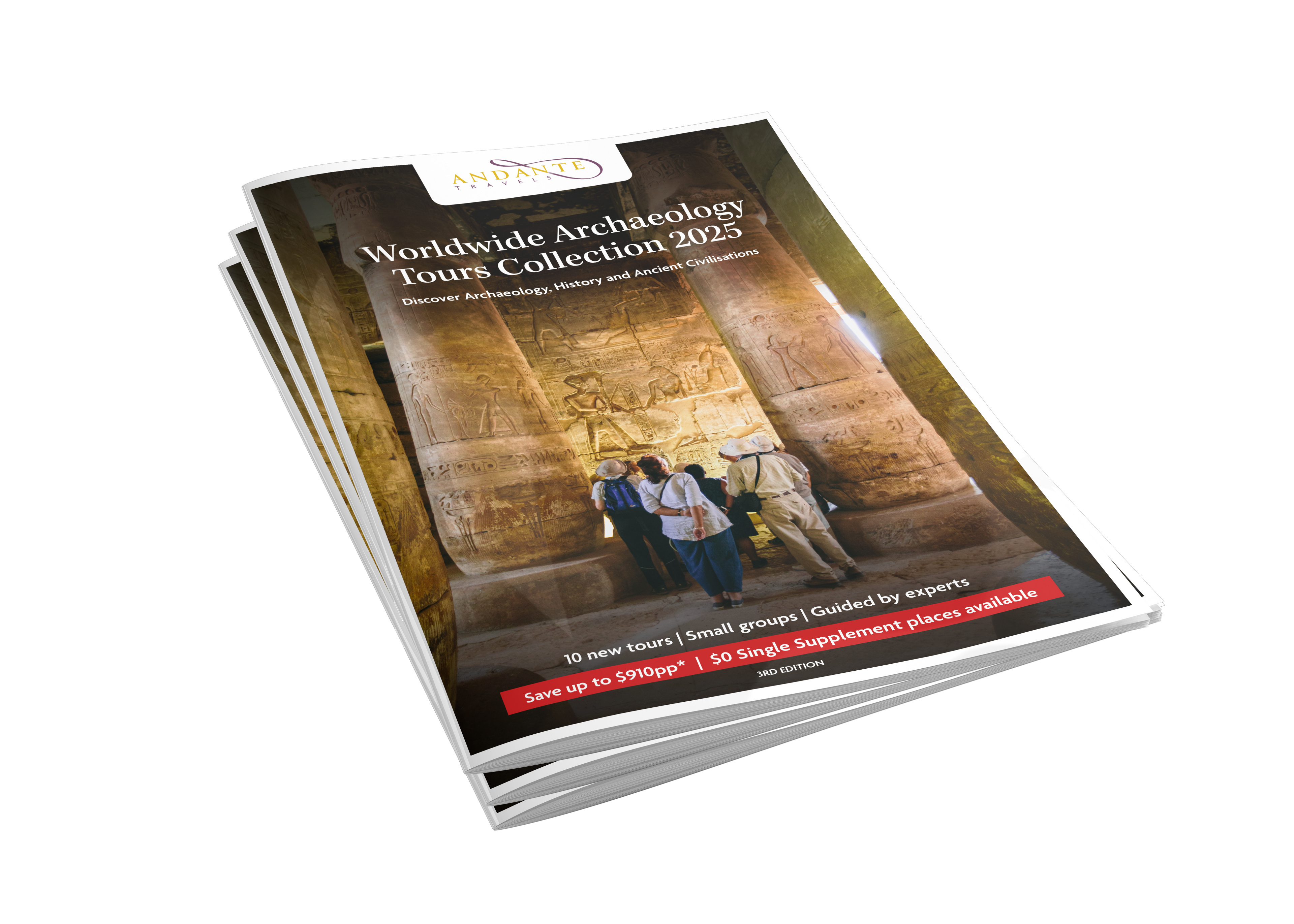Rediscovering Pompeii

The archaeology of Pompeii is endlessly fascinating with an enduring appeal, and its ability to fascinate returning visitors is due in part to the way this archaeological site is constantly changing. At Pompeii, new houses are constantly being excavated and opened up to the public and new finds are often being unearthed, meaning that no two visits are likely to be the same.
Our escorted Pompeii tour is one of our best-sellers and it can take you from the Pompeii archaeological park itself to the crater of Vesuvius and from Naples’ astounding Archaeological Museum to behind-the-scenes at the storerooms of Paestum Museum.
Dr Eireann Marshall, one of our expert Guide Lecturers and a former Wanderlust World Guide Awards winner, will lead one of our flagship Pompeii departures in 2024 and wrote a fantastic article for us about what it means to rediscover Pompeii.
From a hotly-debated eruption date to the grisly fates of citizens, Pompeii is telling new tales – by Dr Eireann Marshall, expert Guide Lecturer for Andante Travels
It’s hard to forget how depressing Pompeii and Herculaneum were just a short while ago. I remember taking a group around Pompeii in 2010, shortly after the Schola Armaturarum collapsed, when that part of the Via dell’Abbondanza was closed off and noting how many guests in the group – like many others after them – were disappointed by Pompeii because most of the houses were shut, and the ones that were open looked dingy. Indeed, at that time, only around 10 sites were open to the public and UNESCO had threatened to label the site as being in peril.
Then, with the ascension of Massimo Ossana as the General Director of the Archaeological Park of Pompeii in 2014, and with the establishment of the Great Pompeii Project, which has invested around €160m in the site, it has turned around remarkably. Now sites, which I was once shown only because I knew the local staff, have opened to the public and a large excavation project has been launched. In fact, over the last couple of years, announcements of new discoveries in Pompeii have been appearing in the news so often that it has been hard to stay abreast of the situation. Throughout this time, I have kept up to speed by speaking to archaeologists working in the field, as well as to people working on the sites, from our local guides to the very active and capable Director of Herculaneum, Francesco Sirano. With this in mind, I thought I would spell out why I think there is no better time to visit the Bay of Naples than now – even if you’ve already been.
Discoveries from the excavations on Regio V: What we have learned Pompeii has been much in the news for the excavations taking place at Regio V, a 54-acre area in the northern part of the park. These excavations, the largest in Pompeii since the 1960s, are funded by the Great Pompeii Project and are being done to both secure the excavation fronts of the unexcavated parts of the city and to ensure that this area is properly drained. The focus of recent excavations has been in the area between the House of Lucretius Fronto and the House of the Silver Wedding. A staggering amount has been found so far, considering that these excavations are being carried out for maintenance purposes. Several houses have been excavated, including the House of Jupiter, the House of Leda and the Swan, the House of the Garden, and4/5 projecting balconies – not including the thermopolium (a shop selling hot food) and a shop/tavern. This has entailed the discovery of new frescoes, mosaics and artefacts. So, what have we learned from this?
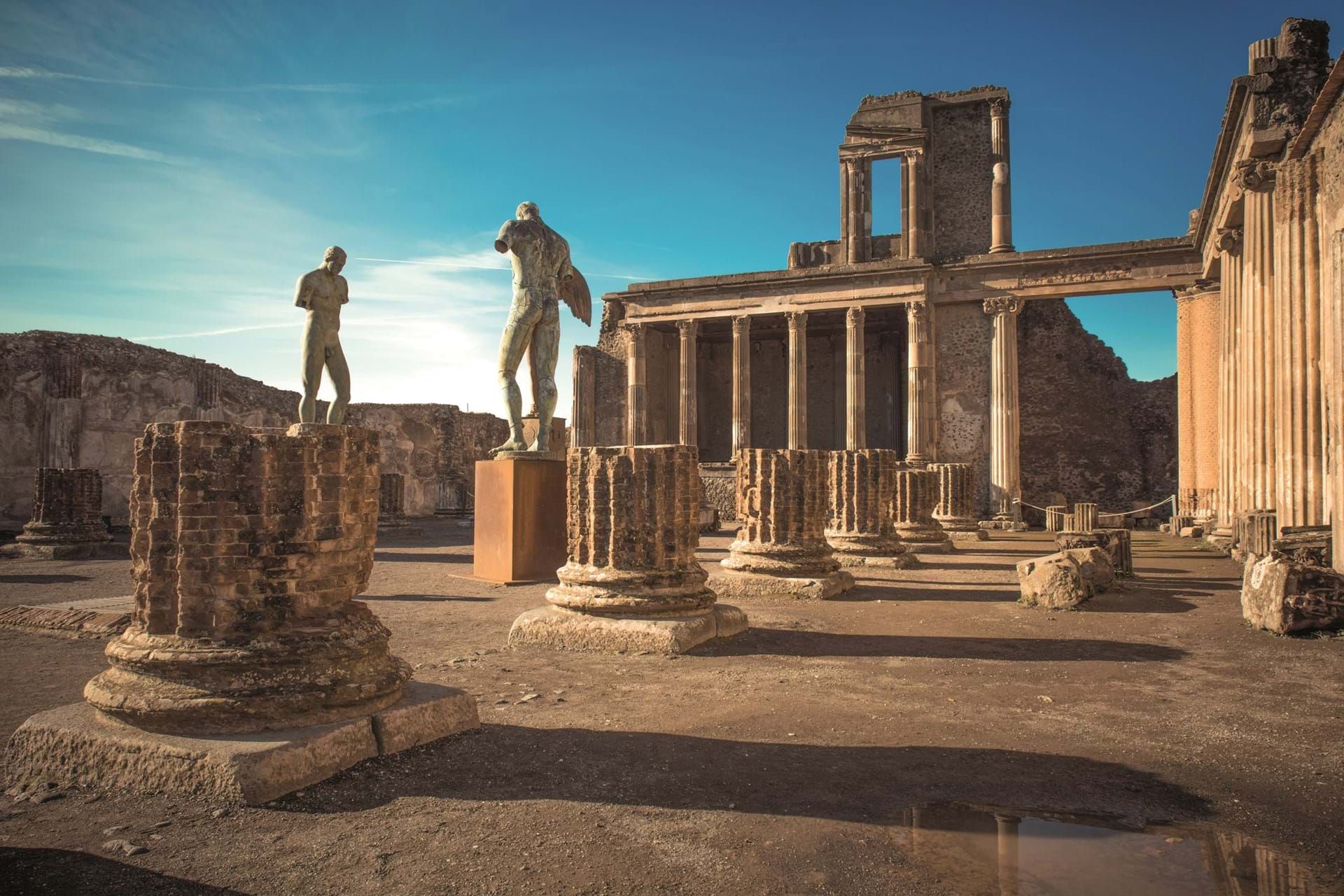

Beautiful works of art
On the most basic level, we have acquired wonderfully preserved works of art, whose pigments are still fresh and tesserae (tiles used to create mosaics) are still undamaged. An intriguing mosaic was discovered in2018 in the House of Jupiter, which is now also known as the House of Orion. The mosaic depicts a man emerging from a giant scorpion and donning butterfly wings, which might be a way of representing the figure as being transformed – also indicated by his head being on fire. The winged figure above this man, pointing upwards, may be interpreted as showing the metamorphosis of Orion into a constellation, rising out of Scorpio. The joy of this mosaic comes from its novel choice of subjects, while the lararium (a shrine in the home for guardian deities) found in October 2018 and the fresco of Leda and the Swan are particularly attractive by their vibrant paintings. Well beyond the artistic merits of the artworks found, discoveries have both shed new light on and added to what we know about the Roman world in the 1st century AD.
Gladiators
A painting found beneath the stairs of a shop or tavern in October 2019 hit the headlines for its subject. There is nothing more attention grabbing than gladiators, and this painting, which depicts a fight between a murmillo and a thraex (both types of Roman gladiators), catches the eye for its overt gore. What is interesting here is not so much the fight between the two gladiators, which is a commonly found motif, but the way in which the fresco characterises one as a clear victor and the other as the loser, whose blood can be seen gushing from his arms and chest. This is something that goes right to the heart of the appeal of gladiators, in that during a struggle between two men or women hell bent on harming each other, one will always emerge victorious. This allows the audience, typically identifying with one of the two fighters, to either feel the thrill of victory or the pang of regret. Particularly intriguing is the way in which the defeated gladiator raises a finger, which brings to the fore the debate about how hand gestures were used to signal either death or mercy to gladiators. While Juvenal – a poet known for his collection Satires– describes the gesture despatching a gladiator as a downward pointing thumb, or the pollice verso (Satire 3.34-37), some scholars including Corbeill have argued that the gesture used was an upward-pointing thumb. The gladiator in this new fresco, in what must be a request for mercy, is offering an all-together different gesture, which may suggest body language wasn’t standardised, just as gladiator types and equipment weren’t always the same.
Sex and decadence
A theme that has never been far from the discussion of these new discoveries is sex. The tavern or shop in which the gladiators fresco was found has variously been described in the press as being a place in which gladiators could have trysts with barmaids based on no evidence whatsoever. Two frescoes from the House of Leda and the Swan, uncovered in November 2018, also reflect modern preoccupations with sex. The reception of the rather graphic fresco of Leda and the Swan, and the equally colourful depiction from the same House of Priapus of the god weighing his impressive phallus, have focused on the erotic nature of the depictions, neglecting the world view of ancient Pompeiians. As myths were associated with Greek literature, the owner of the House of Leda and the Swan would have commissioned the fresco in order to impress his guests with his culture. This is emphasised by the fact that the same house has revealed another painting of a myth, a rather more beautiful megalographia (a depiction of life-sized figures) of Narcissus. So, where we see quite transgressive sex, Pompeiians would have seen erudition. The same owner would have seen the fresco of Priapusin his fauces (a narrow corridor or entryway) as a symbol of good fortune, as the phallus – the essence of masculinity – represented power and luck more than sex. Particularly interesting to me is the way in which the Priapus fresco is so reminiscent of the famous painting in the fauces of the House of the Vettii. It is possible that the owners of the new House of Leda and the Swan, like the Vettii, were freedmen who made their fortune in trade and wanted to show off their good luck with paintings of Priapus as well as their culture through paintings of myths.


The studies of Vesuvian victims
Perhaps the most exciting discoveries are the most gruesome. The new excavations in Pompeii have revealed more bodies than have been found in decades and have done so just when modern technologies have developed, which allows us to study the lives of individuals through their skeletal remains. What makes the Vesuvian bodies crucial is that a range of individuals who didn’t die of natural causes have been uncovered, meaning that archaeologists can study a pool of ordinary, healthy people. The incredible find in February 2019 of a seven or eight-year-old child in the Central Baths, a site that was thoroughly excavated in the 19th century, emphasises just how much archaeology has developed. Where archaeologists in the 19th century presumably left the skeleton in situ because they couldn’t make a good plaster cast of it, modern archaeologists have exhumed the skeleton because of the information it can provide. The most important cache of bodies was found in October 2018 in the House of the Garden, where 10 bodies were found strewn around the room by looters (perhaps before 1748 when the excavations of Pompeii
began) who were most likely only after expensive items. While we await the results of the osteoarchaeological studies of the skeletons, what this moving collection of bodies reveals is that people, in times of crisis, like to congregate with others close to them. The same phenomenon has been seen many times over in Pompeii, famously in the House of Julius Polybius, but also in Oplontis.
Rather more has been revealed about the bodies discovered in the ancient warehouses of Herculaneum in a study from 2018, carried out by Pierpaolo Petrone – a palaeobiologist at the Federico II University Hospital in Naples. Using ICP-MS and Raman miscrospectroscopy, Petrone identified the red and black residues found on the Herculaneum bones, skulls and artefacts as blood that had vaporised, along with other internal bodily fluids, as a result of the extreme heat from the pyroclastic flow that overwhelmed Herculaneum. Examining the cracks in the skeletons and skulls, Petrone concluded that the brains and bodily fluids of the victims had boiled, causing the skeletons to crack, the skull caps to explode and fluids to escape. This demonstrates, in graphic terms, how the citizens of Herculaneum died – of fulminant shock, rather than from asphyxiation. Small comfort can be gained from the fact that the people would have been killed faster than their reaction times would have registered consciousness – ultimately, they died before they knew it.
The cause of death in the 54 individuals found in Oplontis B, however, is far less clear and it is one of the things that a team led by Kristina Killgrove and Nic Terrenato are hoping to learn through 3D photogrammetry and osteological analysis. This building, which appears to be an emporium owned by L. Crassius Tertius on the basis of a seal ring found at the site, has revealed priceless artefacts, including transport vessels, jewellery, food stuffs, and even human remains. The Oplontis Project, led by John R. Clarke and Michael L. Thomas of the University of Texas, has revealed much about the villa and its victims. Using anthropological, isotopic and DNA studies, Killgrove and Terrenato are studying the bones of the Oplontis victims, along with some from Pompeii, in order to get a better picture of the lives of ordinary people, including their diets and pathologies. This is all the more interesting since the 54 victims, huddled in one room on the ground floor, appear to have separated themselves into two groups based on social status.
Their findings so far have suggested that many victims from Oplontis were related (on the basis of dental and skeletal similarities) and that the victims were generally well off. Interestingly, the people found at Oplontis seem to have not suffered from anaemia and appeared to have had balanced diets, although the teeth of some of the children indicate periods of hunger. Unlike the teeth of the Herculaneum skeletons, those of the Oplontis victims show a lot of dental problems. This study’s work with 3D photogrammetry has brought some of these individuals to life. One
of the most moving examples is that of a young woman, who survived a cranial blunt trauma and was 36 weeks pregnant at the time of the eruption, the tiny bones of her foetus having almost all been found entirely reconstructed.
Religious and everyday life
Although recent finds have not offered evidence that revolutionises the way we understand ancient religions, they do give glimpses into the religious or spiritual lives of Pompeiians. A couple of lararia have been found in Regio V, including a spectacular one whose paintings are remarkably well-preserved, accessed from the Vicolo of Lucretius Fronto. Found in 2018, this lararium is one of the largest found in Pompeii and it has a small garden whose plants would have resembled those painted onto the wall. In a wonderful trompe l’oeil, the peacock depicted on the fresco would have looked like it was walking in the garden itself. More poignantly, archaeologists found remnants of burned offerings in a vessel at the foot of the shrine, a tangible link to the Pompeiian family who worshipped here in the hopes of a prosperous future.
Amulets and jewellery found in the House of the Garden in 2019 offer a tantalising glimpse into the world view of Pompeiian women. The finds include two mirrors, some glass beads, a well as a number of pendants in the shape of little phalluses, closed fists, skulls and scarabs, which were originally enclosed in a wooden box that has since disintegrated. The inclusion of scarabs and Harpocrates underlines the popularity of Egyptian cults in this trading town, while the amulets, as a whole, appear to be apotropaic good luck charms.
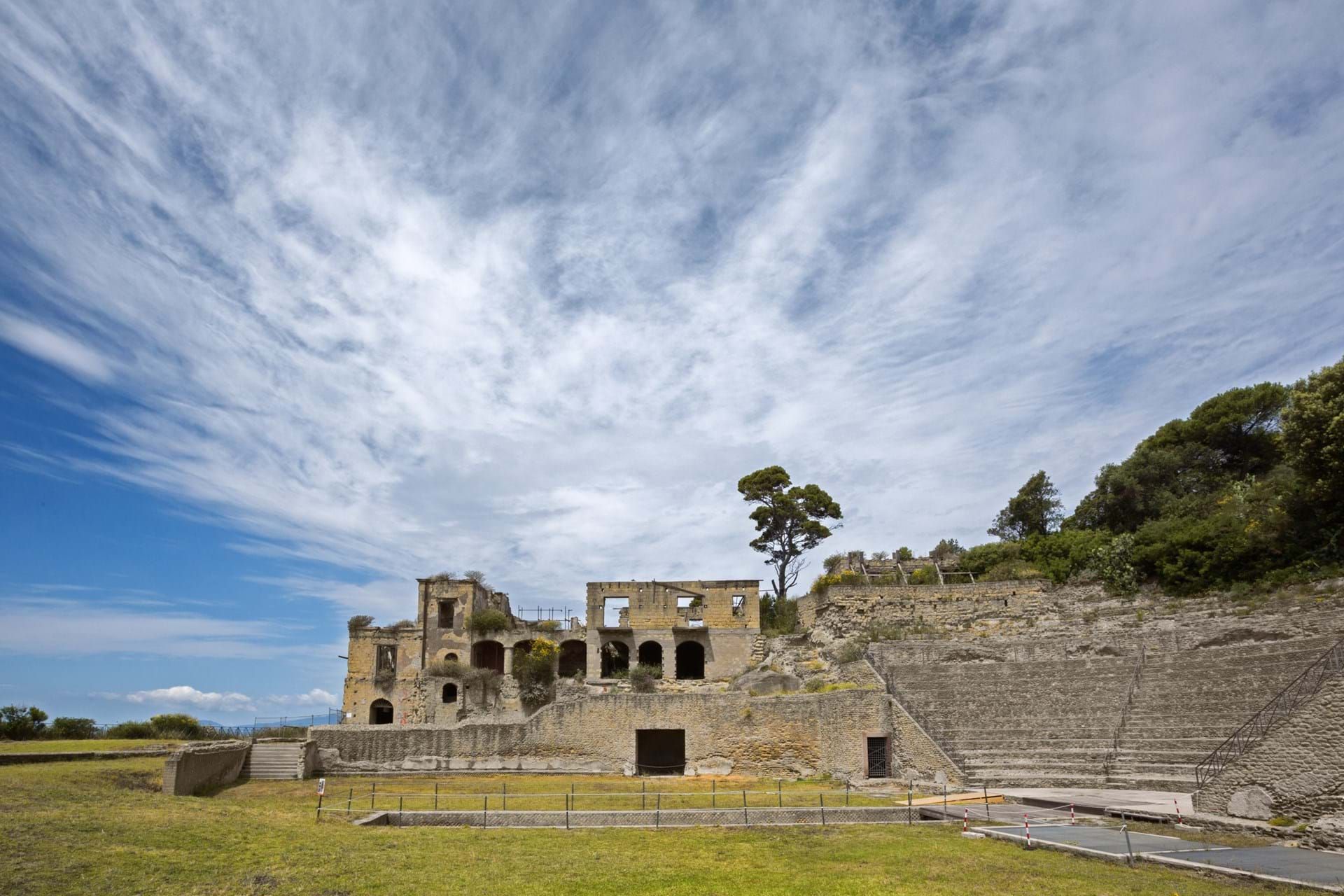
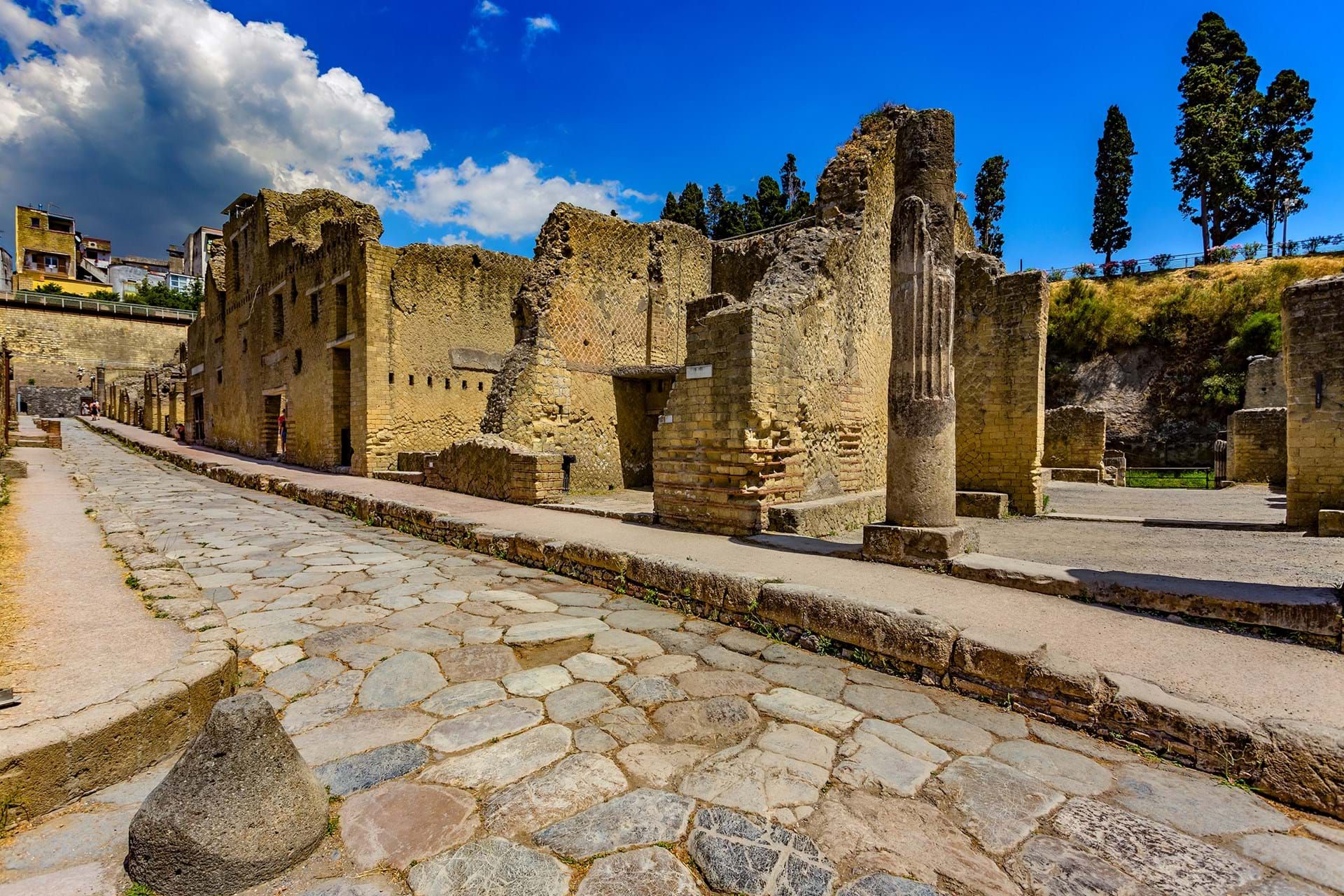
Evidence of a guild
Pompeii was a city full of guilds, such as fullers and silversmiths, which voted in blocks and even provided communal burials for some of their members. Citizens would have identified themselves through their work and their tombs were decorated with work tools. Two designs on opus signinum floors (a type of simple and roughly patterned pavement used in Roman antiquity) in the House of Orion, found in 2019, may shed light into the guild of the surveyors in Pompeii. One depiction may represent a groma, a surveying instrument comprising a vertical pole upon which four arms were fixed that had plumb lines falling from them, which was used to provide straight lines and right angles. The depiction on the floor is one of five parallel lines next to a circle, which appears to be placed on a pole. Another opus signinum floor depicts a square within a circle dissected by two lines. I have never seen these designs on floors and I think they are meant to represent something in particular. I do think that these may well be depicting tools of the surveyors’ trade and that the owner of this house may be simply advertising his work. While I think Osanna’s suggestion – that this is a headquarters for this guild – is too speculative, I believe these designs do show how important work was to defining who Pompeiians thought they were.
The much-discussed eruption date
Perhaps the most publicised discovery from the Regio V excavations is the graffito in a sure hand, which says “XVI (ante) K(alends) Nov(embres) in[d] ulsit pro masumis esurit[ioni]” and can be translated as “17 October (16 days before the Kalends of November) he over-ate”. This was scribbled on one of the walls of the House of the Garden, in one of the rooms that was still being renovated, as is evidenced by the flooring and lack of plastering on some walls. While the graffito doesn’t include a year, the fact that it is written in charcoal – a medium that is easily removed – suggests it was written shortly before the eruption.
For those of us who grew up reading Pliny, the eruption of Vesuvius is firmly etched in our minds as 24 August – or, rather, had been etched until an increasing amount of evidence was assessed, suggesting that the eruption actually occurred in the autumn. The evidence in question includes a dolia full of wine (suggesting a recent wine harvest had been done), the heavier clothes on some of the victims, jars filled with preserved summer fruits, and – perhaps most telling – a coin that celebrated the 15th acclamation of the Emperor Titus, an event that occurred in September AD 79 (the coin must have been minted after this and dispersed throughout Italy afterwards). This charcoal graffito is a lovely addition to this largely settled debate. It has made me realise just how reliant we are on transmitted information.
The reason why 24th August has been favoured until now is that it is included in all translations of Pliny the Younger’s famous account of the eruption – in his letter to the historian, Tacitus (6.16). This date was included in the Codex Laurentianus Mediceus, which Aldus Manutius – the influential Venetian publisher – used for his edition of Pliny’s letters. As the first complete edition of Pliny’s letters, Manutius’ publication has been the basis of later versions and, for that reason, 24 August stuck. We can tell that the 24th August date was a corruption in the manuscript because the date is given as Nonum Kal September rather than the correct a.d. IX kal.sept. Hindsight is a wonderful thing.
New openings
The joy of the Great Pompeii Project is that the new discoveries have been accompanied by the opening of many more sites. Going to Pompeii today is much like visiting another site compared with 10 years ago. Even longer ago, I remember being shown around the praedia (a building of multi-occupancy) of Julia Felix by a custodian, who, in his eagerness to show my students as much of Pompeii as possible, began opening doors to sites forever shut. I was carrying my second son in a pouch on that day, and he is now at his second year at University College London – it has taken almost that length of time to see the site for the second time. Clearly, the most exciting sites to have opened recently are the House of Leda and the Swan from Regio V and the Central Baths. It really is incredible to think that the site director has opened one of the recently excavated houses from Regio V only a year after it was discovered.
Of equal interest is the opening of the Central Baths, which have never been accessible to the public. The largest and most luxurious baths built in Pompeii, the Central Baths were still being built at the time of the fateful eruption. The subject of much restoration work, they occupy an entire insula of Regio IX and were far and away the most modern thermal complex in the city. Alongside these very exciting openings, Osanna has also reopened some houses on the Via del Vesuvio, which have been shut because of the archaeological work being carried out. The most important of these is one of the most beautiful houses in Pompeii, namely the House of the Golden Cupids, which has a spectacular peristyle and an enigmatic shrine to Isis, as well as gorgeous obsidian mirrors embedded into the wall. The house is known from graffiti and a ring said to have been owned by Gnaeus Poppaeus Habitus, a relative of Poppaea – the wife of Nero.
Herculaneum had an equally dramatic turn-around, with more sites being opened and important restorations taking place. I visited the House of the Bicentenary, one of the most prestigious in Herculaneum, the week after it opened and was bowled over by the largely intact trellis, which closed the cubiculum (a private room in a house occupied by a family of high social standing). It is the preservation of these organic materials that makes Herculaneum such a moving site, allowing us not only to better connect with its ancient inhabitants on a visceral level, but to better understand their surroundings. Cubicula must all have had doors or shutters, but it is only here that we get to see them. Along with this house, Herculaneum has also now opened its antiquarium, housing the rowboat found on the shoreline as well as a museum that exhibits some of the more precious items uncovered here.
Over the course of a delightful dinner at the British School of Rome, Francesco Sirano assured me that the museums will remain opened, and alerted me to the imminent opening of yet another museum in Herculaneum, at Portici, which will display organic materials found in the area. The most exciting innovation here, in my view, is the recent opening of the Theatre of Herculaneum. Off-site and still underground, the theatre is famous for its place in the history of Herculaneum – it was the discovery of sculptures from the theatre via a deep well that first alerted archaeologists to Herculaneum’s existence and it is the inscription to Nonius Balbus – Herculaneum’s principle civic benefactor – that identified the site as Herculaneum. Walking through its tunnels, which were excavated in the 18th century, we consider the earliest archaeologists, who, in cramped conditions, forged passageways to remove any priceless works of art they came across.
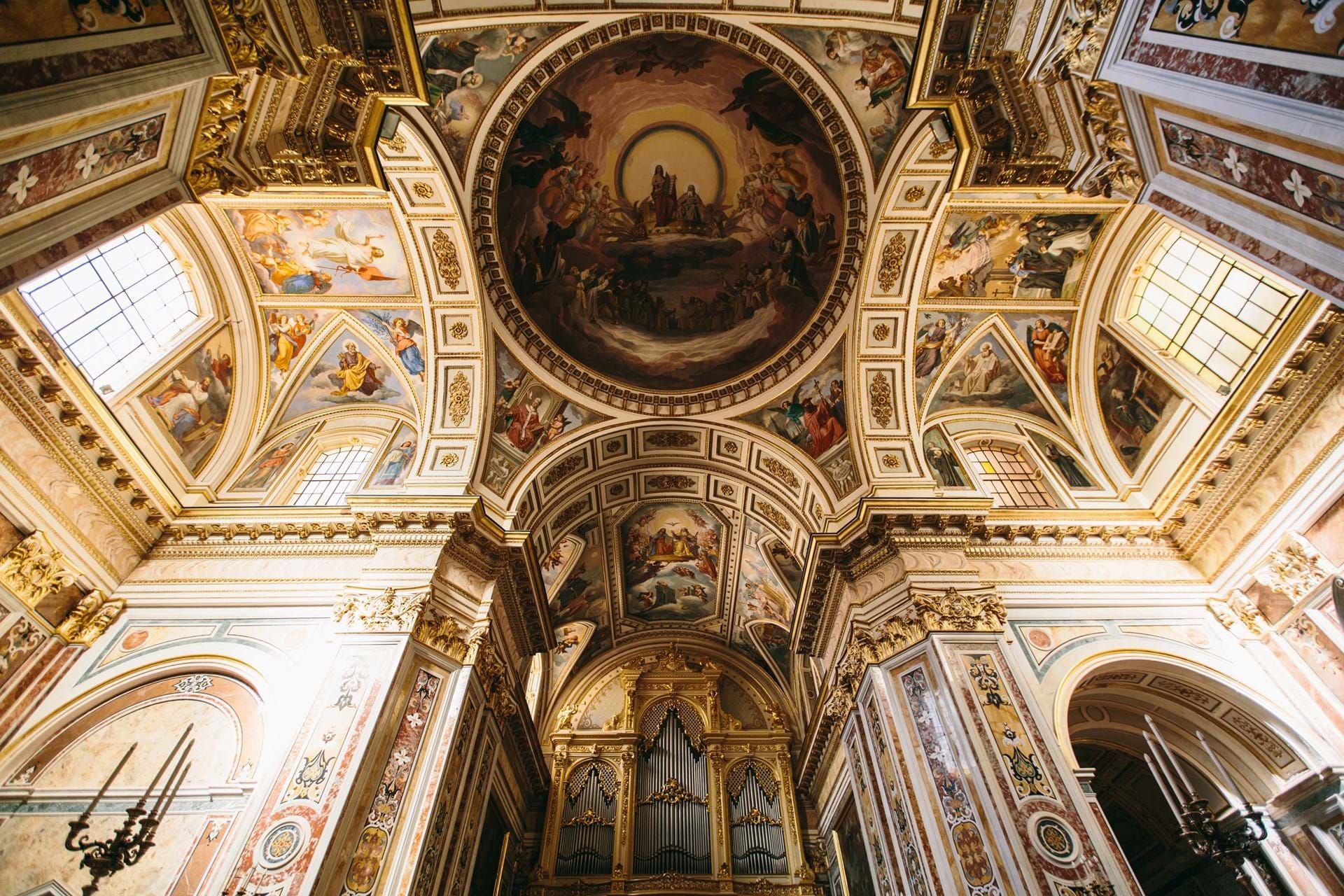

Experience all this and more for yourself
Our Pompeii, Herculaneum & Classical Campania tour has many departures to choose from throughout 2023 and 2024.
Archaeology Tours
NEWSLETTER
Opt-in to our email newsletter and hear about new offers first – view our privacy policy for details.
